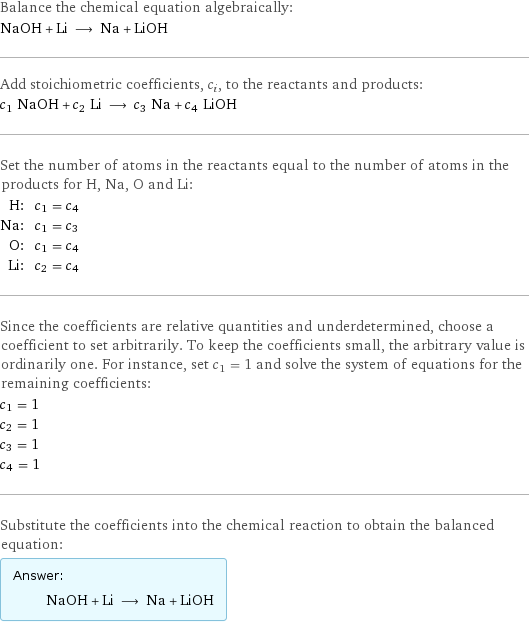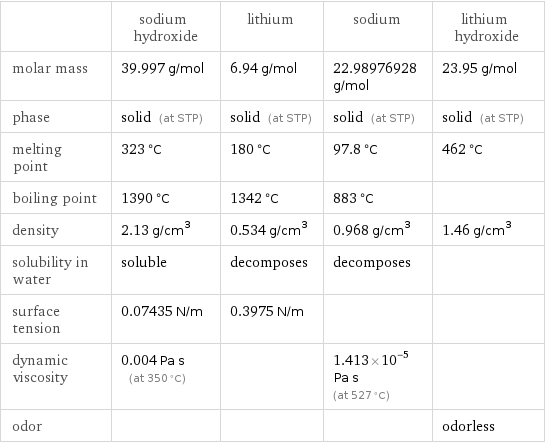Input interpretation

NaOH sodium hydroxide + Li lithium ⟶ Na sodium + LiOH lithium hydroxide
Balanced equation

Balance the chemical equation algebraically: NaOH + Li ⟶ Na + LiOH Add stoichiometric coefficients, c_i, to the reactants and products: c_1 NaOH + c_2 Li ⟶ c_3 Na + c_4 LiOH Set the number of atoms in the reactants equal to the number of atoms in the products for H, Na, O and Li: H: | c_1 = c_4 Na: | c_1 = c_3 O: | c_1 = c_4 Li: | c_2 = c_4 Since the coefficients are relative quantities and underdetermined, choose a coefficient to set arbitrarily. To keep the coefficients small, the arbitrary value is ordinarily one. For instance, set c_1 = 1 and solve the system of equations for the remaining coefficients: c_1 = 1 c_2 = 1 c_3 = 1 c_4 = 1 Substitute the coefficients into the chemical reaction to obtain the balanced equation: Answer: | | NaOH + Li ⟶ Na + LiOH
Structures

+ ⟶ +
Names

sodium hydroxide + lithium ⟶ sodium + lithium hydroxide
Reaction thermodynamics
Enthalpy

| sodium hydroxide | lithium | sodium | lithium hydroxide molecular enthalpy | -425.8 kJ/mol | 0 kJ/mol | 0 kJ/mol | -487.5 kJ/mol total enthalpy | -425.8 kJ/mol | 0 kJ/mol | 0 kJ/mol | -487.5 kJ/mol | H_initial = -425.8 kJ/mol | | H_final = -487.5 kJ/mol | ΔH_rxn^0 | -487.5 kJ/mol - -425.8 kJ/mol = -61.7 kJ/mol (exothermic) | | |
Equilibrium constant
![Construct the equilibrium constant, K, expression for: NaOH + Li ⟶ Na + LiOH Plan: • Balance the chemical equation. • Determine the stoichiometric numbers. • Assemble the activity expression for each chemical species. • Use the activity expressions to build the equilibrium constant expression. Write the balanced chemical equation: NaOH + Li ⟶ Na + LiOH Assign stoichiometric numbers, ν_i, using the stoichiometric coefficients, c_i, from the balanced chemical equation in the following manner: ν_i = -c_i for reactants and ν_i = c_i for products: chemical species | c_i | ν_i NaOH | 1 | -1 Li | 1 | -1 Na | 1 | 1 LiOH | 1 | 1 Assemble the activity expressions accounting for the state of matter and ν_i: chemical species | c_i | ν_i | activity expression NaOH | 1 | -1 | ([NaOH])^(-1) Li | 1 | -1 | ([Li])^(-1) Na | 1 | 1 | [Na] LiOH | 1 | 1 | [LiOH] The equilibrium constant symbol in the concentration basis is: K_c Mulitply the activity expressions to arrive at the K_c expression: Answer: | | K_c = ([NaOH])^(-1) ([Li])^(-1) [Na] [LiOH] = ([Na] [LiOH])/([NaOH] [Li])](../image_source/a2fda20be8b8407cad2a99c8e12ec1f6.png)
Construct the equilibrium constant, K, expression for: NaOH + Li ⟶ Na + LiOH Plan: • Balance the chemical equation. • Determine the stoichiometric numbers. • Assemble the activity expression for each chemical species. • Use the activity expressions to build the equilibrium constant expression. Write the balanced chemical equation: NaOH + Li ⟶ Na + LiOH Assign stoichiometric numbers, ν_i, using the stoichiometric coefficients, c_i, from the balanced chemical equation in the following manner: ν_i = -c_i for reactants and ν_i = c_i for products: chemical species | c_i | ν_i NaOH | 1 | -1 Li | 1 | -1 Na | 1 | 1 LiOH | 1 | 1 Assemble the activity expressions accounting for the state of matter and ν_i: chemical species | c_i | ν_i | activity expression NaOH | 1 | -1 | ([NaOH])^(-1) Li | 1 | -1 | ([Li])^(-1) Na | 1 | 1 | [Na] LiOH | 1 | 1 | [LiOH] The equilibrium constant symbol in the concentration basis is: K_c Mulitply the activity expressions to arrive at the K_c expression: Answer: | | K_c = ([NaOH])^(-1) ([Li])^(-1) [Na] [LiOH] = ([Na] [LiOH])/([NaOH] [Li])
Rate of reaction
![Construct the rate of reaction expression for: NaOH + Li ⟶ Na + LiOH Plan: • Balance the chemical equation. • Determine the stoichiometric numbers. • Assemble the rate term for each chemical species. • Write the rate of reaction expression. Write the balanced chemical equation: NaOH + Li ⟶ Na + LiOH Assign stoichiometric numbers, ν_i, using the stoichiometric coefficients, c_i, from the balanced chemical equation in the following manner: ν_i = -c_i for reactants and ν_i = c_i for products: chemical species | c_i | ν_i NaOH | 1 | -1 Li | 1 | -1 Na | 1 | 1 LiOH | 1 | 1 The rate term for each chemical species, B_i, is 1/ν_i(Δ[B_i])/(Δt) where [B_i] is the amount concentration and t is time: chemical species | c_i | ν_i | rate term NaOH | 1 | -1 | -(Δ[NaOH])/(Δt) Li | 1 | -1 | -(Δ[Li])/(Δt) Na | 1 | 1 | (Δ[Na])/(Δt) LiOH | 1 | 1 | (Δ[LiOH])/(Δt) (for infinitesimal rate of change, replace Δ with d) Set the rate terms equal to each other to arrive at the rate expression: Answer: | | rate = -(Δ[NaOH])/(Δt) = -(Δ[Li])/(Δt) = (Δ[Na])/(Δt) = (Δ[LiOH])/(Δt) (assuming constant volume and no accumulation of intermediates or side products)](../image_source/7148126478dafca28bdce44f8f764df2.png)
Construct the rate of reaction expression for: NaOH + Li ⟶ Na + LiOH Plan: • Balance the chemical equation. • Determine the stoichiometric numbers. • Assemble the rate term for each chemical species. • Write the rate of reaction expression. Write the balanced chemical equation: NaOH + Li ⟶ Na + LiOH Assign stoichiometric numbers, ν_i, using the stoichiometric coefficients, c_i, from the balanced chemical equation in the following manner: ν_i = -c_i for reactants and ν_i = c_i for products: chemical species | c_i | ν_i NaOH | 1 | -1 Li | 1 | -1 Na | 1 | 1 LiOH | 1 | 1 The rate term for each chemical species, B_i, is 1/ν_i(Δ[B_i])/(Δt) where [B_i] is the amount concentration and t is time: chemical species | c_i | ν_i | rate term NaOH | 1 | -1 | -(Δ[NaOH])/(Δt) Li | 1 | -1 | -(Δ[Li])/(Δt) Na | 1 | 1 | (Δ[Na])/(Δt) LiOH | 1 | 1 | (Δ[LiOH])/(Δt) (for infinitesimal rate of change, replace Δ with d) Set the rate terms equal to each other to arrive at the rate expression: Answer: | | rate = -(Δ[NaOH])/(Δt) = -(Δ[Li])/(Δt) = (Δ[Na])/(Δt) = (Δ[LiOH])/(Δt) (assuming constant volume and no accumulation of intermediates or side products)
Chemical names and formulas

| sodium hydroxide | lithium | sodium | lithium hydroxide formula | NaOH | Li | Na | LiOH Hill formula | HNaO | Li | Na | HLiO name | sodium hydroxide | lithium | sodium | lithium hydroxide
Substance properties

| sodium hydroxide | lithium | sodium | lithium hydroxide molar mass | 39.997 g/mol | 6.94 g/mol | 22.98976928 g/mol | 23.95 g/mol phase | solid (at STP) | solid (at STP) | solid (at STP) | solid (at STP) melting point | 323 °C | 180 °C | 97.8 °C | 462 °C boiling point | 1390 °C | 1342 °C | 883 °C | density | 2.13 g/cm^3 | 0.534 g/cm^3 | 0.968 g/cm^3 | 1.46 g/cm^3 solubility in water | soluble | decomposes | decomposes | surface tension | 0.07435 N/m | 0.3975 N/m | | dynamic viscosity | 0.004 Pa s (at 350 °C) | | 1.413×10^-5 Pa s (at 527 °C) | odor | | | | odorless
Units
